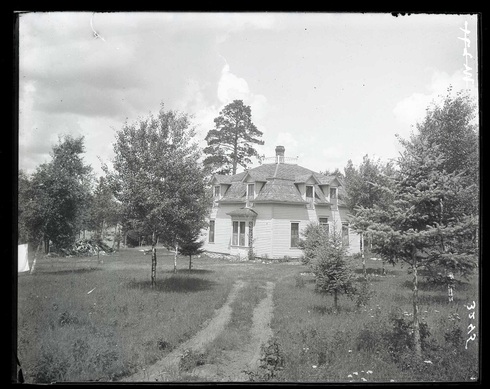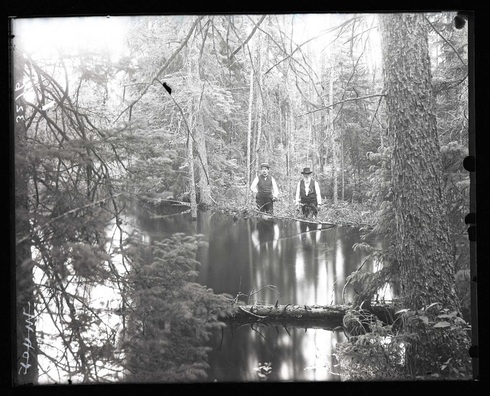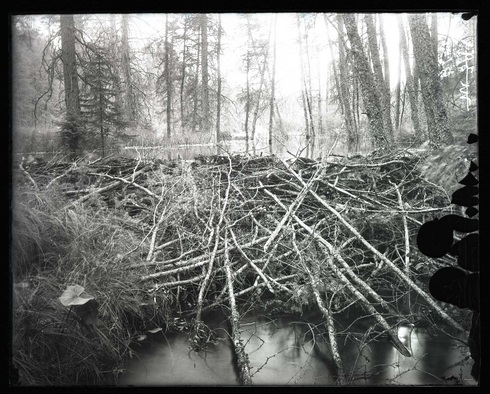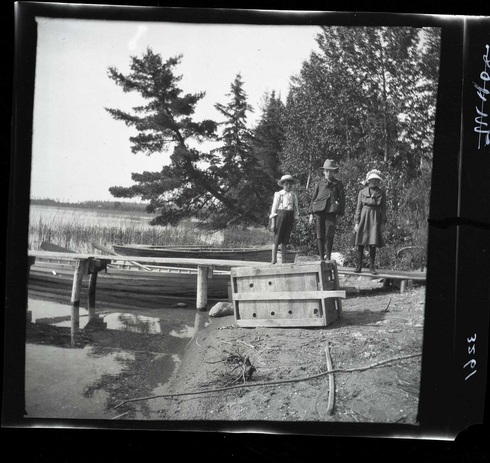While I don’t claim to have a photographic memory, my work over the past several months on the Exploring Minnesota’s Natural History project has fine-tuned my ability to remember images. Having viewed over 12,000 images from negatives, lantern slides, and prints in the Bell Museum of Natural History and Department of Botany records, I regularly find myself mentally “flashing back” to a particular image when it relates to what I am currently working with.
I was recently reading a letter from the correspondence files in the Bell Museum records that Wallace Douglas wrote to Thomas Sadler Roberts, associate curator of the Zoological Museum, in 1917. Douglas was Chair of the Minnesota State Board of Forestry, was the State Attorney General from 1899 to 1904, and also served as a Minnesota Supreme Court Judge from 1904-1905. Douglas Lodge in Itasca State Park was named after Wallace Douglas due to the part that Douglas played in developing the early infrastructure of the park.
In the letter, Douglas recalled to Roberts the history of the introduction of beavers into the park. As I read the letter, I found myself recalling several images from negatives that Roberts produced on a visit to Itasca State Park in the summer of 1902. I have included the images below to illustrate the transcription of Douglas’s letter:
December 14, 1917, Wallace Douglas of Douglas, Kennedy, and Kennedy, Attorneys at Law, St. Paul to Thomas Sadler Roberts:
“My dear doctor: My apologies are due for not replying earlier to your favor concerning the introduction of beaver in Itasca Park.
I recall in detail meeting you at the old Park House in Itasca Park in July, 1902 and your kindness in taking Mr. Gibbs, the Park Commissioner, and myself on a trip to visit the first beaver dam built by the beaver, which were introduced there the year prior. You had just located this dam which was situated on Nicollet Creek.”

– Itasca Park House, July 1902

– Wallace Douglas and Park Commissioner Gibbs at the beaver dam on Nicollet Creek, Itasca State Park, July 1902.

– Beaver dam at Nicollet Creek in Itasca State Park, July 1902
“The early history of the beaver is as follows:
In the summer of 1900 the Superintendent of Algonquin Park in lower Canada, or someone in charge of the park, wrote Gov. Lind with reference to the subject of beaver in Minnesota and kindly offered on behalf of the Dominion of Canada to donate four beaver to the State of Minnesota. Gov. Lind personally took the matter up with me and assented to my request that they be accepted and placed in Itasca Park. Some time in the summer or fall of 1901, after Gov. Lind had been defeated for re-election, Gov. Van Sent was surprised one day by a call from a Forest Ranger from Canada, named Timothy O’Leary, who announced that he had two male and two female beaver down at the St. Paul depot which he was ordered to present to the State of Minnesota on behalf of the authorities in charge of Algonquin Park. One of the males was dead and he was insistent that an inspection of the animals be had by some public official and a certificate of death furnished him. Gov. Van Sent came in with Mr. O’Leary and submitted the legal question to me as Attorney General as to what disposition could be made of the beaver and was very greatly relieved when I claimed them for the Park. I sent them up to Itasca Park with directions that they be liberated upon the shore of the Little Mississippi, but they were in fact placed upon Schoolcraft Island and it seems, promptly swam over to the Little Mississippi and established their first residence on Little Nicollet Lake just above where you located the dam. These beaver were sent for the express purpose of permitting the public authorities of Minnesota to see what could be done in the matter of propogating them.
I am keeping up my interest in the subject as a member of the Forestry Board and last year visited some of the houses of the beaver in Itasca Park, and was indeed glad to receive information from you to the effect that you had made a careful examination of a large number of their habitations in the Park and believe that from these beaver at least 2000 have been produced in and about the Park. We have taken very great pains during the past sixteen years to protect them in their new home, but have been advised that a very few of them were trapped outside of the park two or three years ago. Mr. Cox, State Forester, estimates that there are upwards of 600 of them now in the Park and we are thinking of introducing some outside specimens to assist slighting in preventing too much in-breeding. During the past month we have procured the approval of the Attorney General and executive agent of the Game and Fish commission to trap seventy-five males in January (when the skins will be prime). The Game and Fish Commission will sell their pelts and we hope to have the money turned into the State Treasurer to the credit of the Itasca Park Fund.
I think with you that this is an interesting and marvelous example of increasing wild animal life under protection…
Douglas included a hand-written note with the typed letter:
“Dimensions of the box in which the 4 Beaver were shipped from Toronto to Itasca Lake in July, 1901. The box was of galvinized sheet iron bound with a wooden casting. It lay on the shore by the landing at the “Park Home” in the summer of 1902, where T.S. Roberts photographed and measured it in August of that year.
The box contained four beaver when started on its journey – two males and two females – but one of the males died before the box reached St. Paul. The three were liberated at Schoolcraft Island in Itasca by the then Commissioner Gibbs, about August 1, 1901. These beaver were small – apparently the young of the year. Box measured 38x22x24.”

– At boat landing at Park House with box that beaver came in in foreground, Tom and Catherine Roberts on landing with small boy from Heinzelman’s Store, 1902.
Now that I was reminded to recall these wonderful images from the early history of Itasca State Park, I have to continue to share the others – several hundred images of early structures, residents, and landscapes. It just so happens that today, Sunday, April 20th, marks the 123rd anniversary of the founding of Itasca State Park. Follow along as Exploring Minnesota’s Natural History celebrates “Itasca State Park Week” with a new post about the history of Minnesota’s first state park each day this upcoming week.